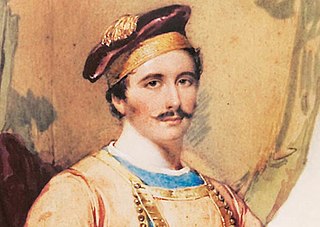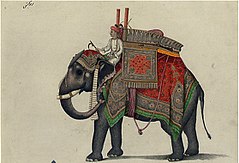
Bahadur Shah II, usually referred to by his poetic title Bahadur Shah Zafar was born Mirza Abu Zafar Siraj-ud-din Muhammad and was the twentieth and last Mughal Emperor of India as well as an Urdu poet. He was the second son and the successor to his father, Akbar II, who died on 28 September 1837. He was a titular Emperor, as the Mughal Empire existed in name only and his authority was limited only to the walled city of Old Delhi (Shahjahanbad). Following his involvement in the Indian Rebellion of 1857, the British exiled him to Rangoon in the British-controlled Burma in 1858, after convicting him on several charges.

Ustad Mansur was a seventeenth-century Mughal painter and court artist. He grew up during the reign of Jahangir during which period he excelled at depicting plants and animals. He was the earliest artist to depict the dodo in colour, apart from being the first to illustrate the Siberian crane. Towards the end of Akbar's reign, he gained the title of ustad (=master) and during the reign of Mughal Emperor Jahangir his masterpieces earned him the title of Nãdir-al-’Asr. Although largely known for his natural history illustrations, he also portrayed people in various manuscript illustrations.

Sepoy was the Persian-derived term from the word "sipahi" or a professional Indian infantryman, traditionally armed with a musket, in the armies of the Mughal Empire.

William Dalrymple is a Delhi-based Scottish historian and art historian, as well as a curator, photographer, broadcaster and critic. He is also one of the co-founders and co-directors of the world's largest writers festival, the annual Jaipur Literature Festival.

Mughal painting is a style of painting on paper confined to miniatures either as book illustrations or as single works to be kept in albums (muraqqa), from the territory of the Mughal Empire in South Asia. It emerged from Persian miniature painting and developed in the court of the Mughal Empire of the 16th to 18th centuries. Battles, legendary stories, hunting scenes, wildlife, royal life, mythology, as well as other subjects have all been frequently depicted in paintings.

Govardhan was a noted Indian painter of the Mughal school of painting. His father Bhavani Das, had been a minor painter in the imperial workshop. Like many other Mughal painters, they were Hindus. He joined the imperial service during the reign of Akbar and he continued his work till the reign of Shah Jahan. The examples of his work survived till date show that he was fond of rich, sensuous colour and softly modeled forms.

Abu'l-Hasan, from Delhi, India, was a Mughal painter of miniatures during the reign of Jahangir.

Company style, also known as Company painting or Patna painting is a term for a hybrid Indo-European style of paintings made in India by Indian artists, many of whom worked for European patrons in the East India Company or other foreign Companies in the 18th and 19th centuries. The style blended traditional elements from Rajput and Mughal painting with a more Western treatment of perspective, volume and recession. Most paintings were small, reflecting the Indian miniature tradition, but the natural history paintings of plants and birds were usually life size.

Sir Thomas Theophilus Metcalfe, 4th Baronet, KCB was an East India Company civil servant and agent of the Governor General of India at the imperial court of the Mughal Emperor Bahadur Shah Zafar.

The Last Mughal: The Fall of a Dynasty, Delhi 1857 is a 2006 historical book by William Dalrymple.
Stuart Cary Welch Jr. was an American scholar and curator of Indian and Islamic art.

The illuminated manuscript Khamsa of Nizami British Library, Or. 12208 is a lavishly illustrated manuscript of the Khamsa or "five poems" of Nizami Ganjavi, a 12th-century Persian poet, which was created for the Mughal Emperor Akbar in the early 1590s by a number of artists and a single scribe working at the Mughal court, very probably in Akbar's new capital of Lahore in North India, now in Pakistan. Apart from the fine calligraphy of the Persian text, the manuscript is celebrated for over forty Mughal miniatures of the highest quality throughout the text; five of these are detached from the main manuscript and are in the Walters Art Museum, Baltimore as Walters Art Museum MS W.613. The manuscript has been described as "one of the finest examples of the Indo-Muslim arts of the book", and "one of the most perfect of the de luxe type of manuscripts made for Akbar".

James Otto Lewis was an American engraver and painter who was noted for his portraits of Native American leaders and other figures of the American frontier. Lewis began his engraving career in Philadelphia about 1815.
Ghulam Ali Khan was a nineteenth century Indian painter in Delhi. His painting career took place over the course of more than four decades, from 1817 to 1852. He was the last royal Mughal painter, and also painted in the Company style for British patrons.

William Fraser was a British India civil servant who was an Agent to the Governor General of India and Commissioner of the Delhi Territory during the reign of the last Mughal Emperor, Bahadur Shah Zafar. He was a brother of James Baillie Fraser.

Delhi Book or Delhie Book titled Reminiscences of Imperial Delhi is a collection of paintings done in Company style, commissioned by Sir Thomas Metcalfe in 1844. It contains 120 paintings by Indian artists, mainly by Mughal painter, Mazhar Ali Khan. The book was bought by the British Library in London.
Ghulam Murtaza Khan (1760–1840) is a Mughal era, 19th century painter from Delhi. He worked under penultimate Mughal emperor Akbar Shah II. He worked under British officers, Skinner and William Fraser. The painting style was known as company style.

The Anarchy: The Relentless Rise of the East India Company is a 2019 history book by William Dalrymple. It recounts the rise of the East India Company in the second half of the 18th century, against the backdrop of a crumbling Mughal Empire and the rise of regional powers.

In Islamic art, a shamsa is an intricately decorated rosette or medallion which is used in many contexts, including manuscripts, carpets, ornamental metalwork and architectural decoration such as the underside of domes. It can take a number of overall shapes, from circles to stars. The name means "little sun", as a diminutive of shams, the Arabic word meaning "sun", and the work is often stylised as a sunburst. It is characterized by the recurrent motifs present in Islamic art, such as the use of geometrical floral or vegetal forms in a repetitive design known as an arabesque. The arabesque is often used to symbolize the transcendent, indivisible and infinite nature of God, and as with other patterns and forms of Islamic art, the shamsa also has a religious significance, such as symbolizing the unity of God.

The Nasser D. Khalili Collection of Islamic Art includes 28,000 objects documenting Islamic art over a period of almost 1400 years, from 700 AD to the end of the twentieth century. It is the largest of the Khalili Collections: eight collections assembled, conserved, published and exhibited by the British-Iranian scholar, collector and philanthropist Nasser David Khalili, each of which is considered among the most important in its field. Khalili's collection is one of the most comprehensive Islamic art collections in the world and the largest in private hands.



















